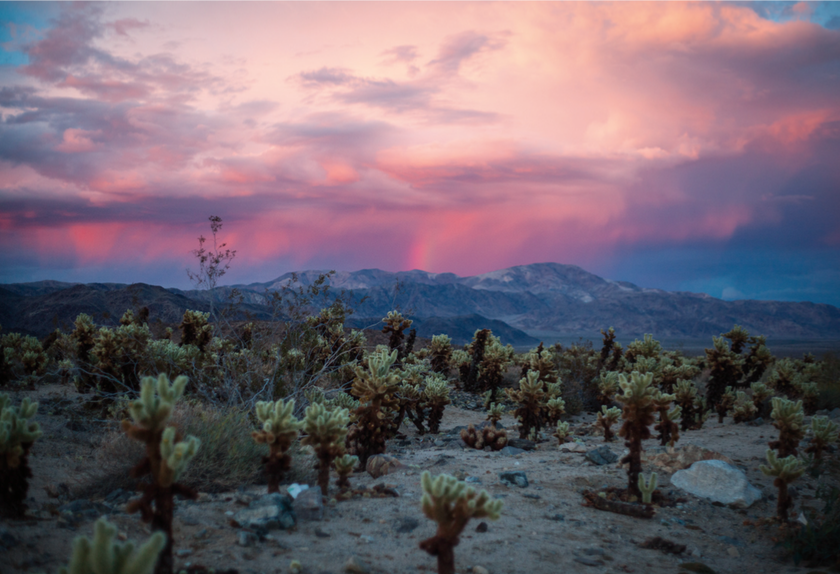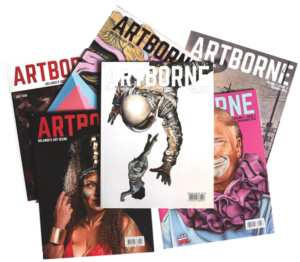How living in the small town of 29 Palms, California, helped my writing evolve.
When I drove into 29 Palms this April, it rained. For those who have lived in the Mojave for a long time, rain is a miracle. To me, a Floridian, rain is a beautiful work of art that I know well, a work of art that I am grateful for. On my drive into town, I remember the way each rainbow’s root touched the bare earth. In the Mojave, there’s land everywhere you look. Bare land, pure Earth. And then there are cacti and mesquite and other gorgeous forms of life that grow, unobtrusively, with gentle spaces between them.

Fish, Cholla Cactus Garden (Joshua Tree National Park), digital photograph Model: Cassandra Davis, owner of Wonder Wellness Yoga in Twentynine Palms, California
This bare Earth, these loose plants, drew me to the Mojave. Here, the landscape brings ease to my mind, my heart, and even my body. I went to 29 to write, to finish my newest book of poems, Bomb, which focuses on the human heart, how it recovers from abandonment. When I am in silence for long stretches of time, when my yoga practice is strong, and when I care for my body by hiking in nature, my writing thrives. When I dive deeply into yoga philosophy, into devotion, my writing thrives. I knew I could do these things in the quiet, open desert.
When I walked into my rental, my skin was wet with desert rain. The sky, pink and glorious, covered me with a mist that smelled metallic, sweet. There was so much I wanted to do here: I wanted to explore the unmarked dirt roads, hike the mountains, become friends with a gifted yoga teacher who I had yet to meet. But for that night, I rested, and I watched the sky turn a deep, dark purple. When I woke, the first thing I saw when I stepped outside was this: blue sky and one colossal mountain.
When I landed in 29 Palms, I didn’t know how long I would stay. I ended up staying for two months. After my devotional yoga practice, I would write. And every time I came to my pen, I asked myself, “What do I want this poem to teach me?” and I would pray for openness in my poetry, I would pray for a miracle—like desert rain. In the Mojave, finishing my book felt a lot like falling in love. By practicing yoga, I became emotionally open enough to cultivate a magnificent form of trust: I trusted my poetry to respond to the land, and I trusted the land to help me feel less afraid—afraid of abandonment, afraid of harm.

Cholla Sunset, Cholla Cactus Garden (Joshua Tree National Park), digital photograph
I trust the Mojave to help me because of its courageous history; its large, intricate rock formations took shape over 100 million years ago. These gigantic monzogranite boulders began as molten liquid. The Earth’s crust moved; the liquid oozed, then cooled underground. When the molten liquid cooled, it became the beginning—the beginning of the boulders I spent so many days with in the desert.
These boulders have endured erosion, groundwater percolation, arid weather, and flash floods. I can’t tell you how many times I walked into the Mojave’s wide and nourishing landscape, placed my hand on one of these boulders, and thought, Please. I need to learn how to love, and I am so afraid of being left behind. I can’t tell you how many times I’ve received answers—kind answers, patient answers. Each answer made its way into my poetry, my book.
This strong and resilient landscape has earned its shapes.
In yoga, you earn your shapes, or your asanas, by practicing steadily and mindfully, by delving into your sequences with devotion. In art, you earn your “finished” piece by fully and wholeheartedly investing your entire being into your work.
Without landscape, without yoga, I would not have the courage to be an artist, to explore this world, to hold its hand. The Mojave landscape is one of my dearest teachers. For that, my gratitude is boundless.
You can see more at: AshleyInguanta.com


